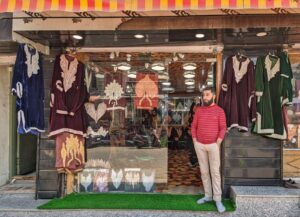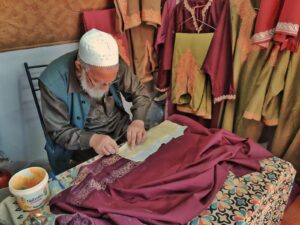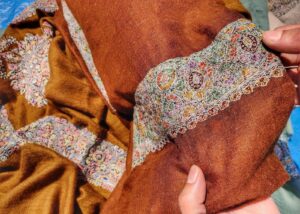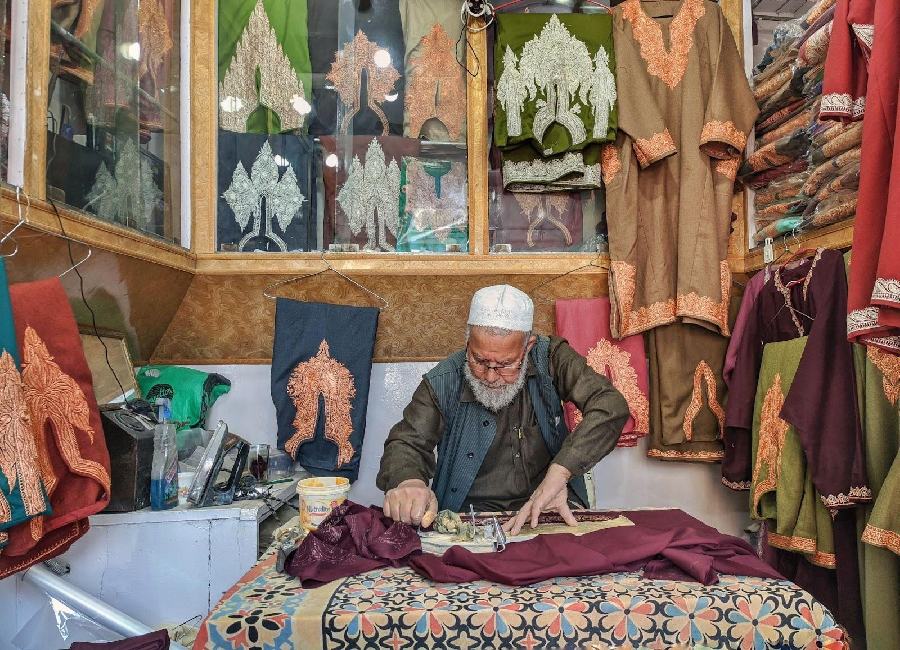With a bitsy needle, Ghulam Mohammad weaves gold and silver thread into elegant patterns on a silk pheran. ‘My eyesight has weakened as a result of the craft’.
 An octogenarian associated with the craft for the past 65 years, he is currently working on a pheran for a bride whose wedding is due later this year.
An octogenarian associated with the craft for the past 65 years, he is currently working on a pheran for a bride whose wedding is due later this year.
Tilla embroidery is one of the most prevalent forms of embroidery in Kashmir. It is believed to have originated in Zari in Khorasan, Iran.
It arrived in Kashmir when Mir Syed Ali Hamdani along with 700 associates arrived from Persia to preach Islam in the Himalayan region.
The Mughal rulers, who were impressed with the exquisite craft, later elevated it, and tilla embroidery was used in their royal courts as well.
“This is something I have been doing for the past 60 years. By God’s grace I am able to make a decent income from it and feed my family,” says the artist, concentrating intently on the needle point.
“Mye chu gaash ti gomut wani,” he adds while fixing his dusty glasses – My eyesight has weakened as a result of the craft.
Tilla work is usually done on the garment’s lower neck, cuffs, and lower hem.
 “Tilla was once solely done on pherans. For the last few years, people have started doing tilla work on shawls and suits as well.”
“Tilla was once solely done on pherans. For the last few years, people have started doing tilla work on shawls and suits as well.”
Machine tilla, according to Ghulam Mohammad, has taken a toll on their livelihood.
“Handmade tilla has seen a rapid decline since the introduction of machine tilla. It is around five times less expensive than handmade,” he explains.
“It takes me 2-3 weeks to complete a handmade tilla pheran depending on how much embroidery the customer wants, whereas machine tilla can be done within a day or two.
“People prefer machine tilla over handmade. But handmade tilla has a separate customer base.”
He adds that the elegance of handmade tilla never goes out of vogue.
Yasmeena, 45, supports her family by doing sozni work on shawls.
“I am no longer reliant on anyone. By doing sozni work I am able to manage my own expenses,” she tells #KhabarLive.
 Yasmeena has been associated with the craft for the past ten years.
Yasmeena has been associated with the craft for the past ten years.
“My husband lost his job in 2010 as a result of political unrest. Sozni work was the only source of income.”
Ruby Jan, Yasmeena’s daughter, learnt sozni work last year and has been practising it ever since.
“During the covid lockdown, my mother taught me the art of sozni work. Now that I have mastered it, I make around 4000 rupees per month” says Ruby, who is also pursuing an MBA.
Demand for sozni, like tilla, has plummeted in recent times.
With technological changes, companies have begun producing machined shawls, threatening the livelihoods of thousands of artisans.
“Handmade sozni shawls are quite pricey. They are not affordable for everyone. People began to prefer low-cost fashion over handcrafted masterpieces as a result of the introduction of machine-made goods,” says Ruby.
Yasmeena says that artists are underpaid for their work.
“I get Rs 300 to 700 per shawl, whereas the merchant sells it for 8 to 10,000 in the market. This is unjust. The government should look into it and take necessary steps for the welfare of these artisans. Even a manual labourer earns more than us,” adds Ruby.
Ghulam Mohammad emphasises that if the government does not take the necessary steps for artisans’ welfare, the handicrafts sector in Kashmir will die a silent death. #tohyd #hydnews

